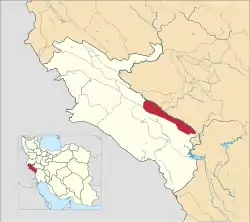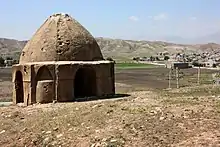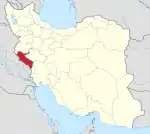Darreh Shahr County
Darreh Shahr County (Persian: شهرستان درهشهر) is a county in Ilam Province in Iran. As of 2016 census, the county's population is 43,708, in 12,012 households.[2] It is the sixth-most populous county in Ilam Province. The county is named after Darreh Shahr as the seat. subdivided into two districts: the Central District and Majin District.
Darreh Shahr County
شهرستان درهشهر | |
|---|---|
 | |
| Coordinates: 33°08′N 47°22′E | |
| Country | |
| Province | Ilam Province |
| Seat | Darreh Shahr |
| Bakhsh (Districts) | Central District, Majin District |
| Government | |
| • Governor | Hossein Ali Mousavi [1] |
| Area | |
| • Total | 1,480 km2 (570 sq mi) |
| Population (2016) | |
| • Total | 43,708 |
| • Density | 29.6/km2 (77/sq mi) |
| Time zone | UTC+3:30 (IRST) |
| • Summer (DST) | UTC+4:30 (IRDT) |
| Area code(s) | (+98) 84 3522 |
Geography
Darreh Shahr county has an area of 1,480 km2 (570 sq mi). Darreh Shahr is bounded by Kabir Kuh range to the south and Seymareh and Karkheh rivers to the north. The plains between the mountains and the rivers are fertile farmlands being cultivated for millennia. There are about 1,220 km2 (470 sq mi) of woodlands in the county, most of which are on the higher altitudes of the Kabir Kouh range to the south. The Kabir Kouh Protected Area is the most important conservation area in the county. It was established in 2001 and has an area of 179 km2 (69 sq mi) between the elevations of 950-2790m on the northern, greener, side of Kabir Kouh.[3]
Rivers
- Seymareh River
- Karkheh River
- Darreh Shahr River
- Sikan River
Lakes
- Seymareh Dam Lake
Climate
Darreh Shahr County has a warm climate with hot dry summers and mild wet winters. July-August maximum daily temperature can as high as 48 °C (118 °F) during heat waves, which are frequent in summer due to proximity to the Iraqi desert. Winters are generally mild but occasionally goes below freezing.[4]
The long-term average annual precipitation is 465.1 mm (18.31 in) at Darreh Shahr Weather Station. The lowest annual precipitation happened during the farming season of 2007–2008 with a figure as low as 188.2 mm (7.41 in). The highest annual precipitation used to be 872.7 mm (34.36 in) in 1990–1991, after which, a deadly flood ensued. This record was broken in 2018–2019 with 1,046.5 mm (41.20 in), which again resulted in a heavy flooding in southwestern Iran.[4]
There is almost no precipitation through the months of June to September. Darreh Shahr used to receive snow once or twice a year in the past, but nowadays it has become less and less likely thanks to global warming.[4] Hail and lightning storms are not uncommon in Fall and Spring and have devastating effects on crops and the farming-dependent economy of the county.
Western air masses from the Mediterranean and Black Sea are cause autumn and winter rains in the province, and Sudanese and Red Sea and Saudi Arabia currents are also effective in winter and spring rains and cause warm weather in summer. The vast plains of Iraq create a low-pressure high-temperature low-humidity weather cell over the area.[5]
Seymareh Landslide
In prehistoric times, a huge landslide occurred in the south eastern parts of Kabir Kuh range. The incident is described in an article on Royal Geographical Society, published in 1937 by Harrison and Falcon. Based on their observations, the landslide is 9 by 2.5 mi (14.5 by 4.0 km) in area and 1,000 to 1,500 ft (300 to 460 m) in thickness; amounting to a body of material of about 30 km3 (7.2 cu mi), some of which is found around 10 mi (16 km) from their original location. The reason for this colossal event is very likely to have been a catastrophic earthquake. Due to its enormity, the Seymareh Landslide is believed to be the largest one recorded in the eastern hemisphere. [6]
Demographics
Darreh Shahr County is composed of two districts: Central District and Majin District. As of the 2016 Iran census, Darreh Shahr county has a population of 43,708 of which 39,562 reside in the Central District and 4,146 in Majin District.
Abdanan County and Badreh County used to be districts of Darreh Shahr County before 1995 and 2013 respectively, after which were upgraded to county (bakhsh) themselves.
Neighboring counties
- Abdanan – south
- Badreh – northwest
- Rumeshkhan County, Lorestan – north
- Pol-e Dokhtar County, Lorestan – east
Darreh Shahr and more generally, the Ilam Province are underdeveloped compared to other areas of Iran. For the same reason, some people, tend immigrate to other cities, mostly Tehran, Karaj and Khorramabad.
Economy
The economy of Darreh Shahr is mostly based on agriculture and animal husbandry. As of February 2018, Darreh Shahr farmers produce more than 190,000 tons of agricultural and 23,000 tons of livestock products annually. Darreh Shahr has about 40,000 ha (99,000 acres) of farming irrigated and dry lands.[7] The agriculture market in Darreh Shahr is worth around USD 17.7m.[8]
| Crop | Annual Production |
|---|---|
| Cucumber | 100,000[10] |
| Wheat | 30,000 |
| Broad bean | 9,000[11] |
| Melon | 4,500[12] |
| Maize | 1,200 |
| Canola | 700[13] |
| Mung Bean | 500 |
| Grapes | 245 [14] |
The warm climate, rich soil and the presence of numerous rivers such as Seymareh and Karkheh and many other minor local streams in the area has made Darreh Shahr County a major agricultural hub in Ilam Province and the Southwest Iran, much like Dezful in Khuzestan Province. A wide variety of crops are cultivated in the county:
- Wheat, barley, maize, rice, sesame and canola;
- Vegetables such as cucumber, aubergine, tomato, zucchini, okra, chili and bell pepper;
- Melons;
- Herbs; and,
- Orange, lime, lemon, grapes and olives.
Animal husbandry, mainly cattle and livestock is another important source of income for the residents of the rural areas. There is also a noticeable number of chicken farms in the county.
Darreh Shahr is a large producer of daffodils with about 230 hectares (570 acres) of cultivated farms and an average annual production of 7 million flowers, most of which is marketed in cities of Tehran, Isfahan, Ahvaz and Arak.[15][16]
The majority of the people living in urban areas, especially Darreh Shahr, work in construction and services trades sector. As the county seat, Darreh Shahr hosts almost all of the government offices of the county, therefore many people work for the government.[17]
Despite the rather solid agriculture sector, the industry sector is emerging and small. Darreh Shahr Industrial City hosts a number of SMEs, the most prominent of which are Seif Ghostar Food Products Company and Madakto Steel Cord Company, the first and only steel cord producer in Iran.[18][19] Darreh Shahr Flour Factory, established in 1993, is a wheat flour milling plant with an installed capacity of 120 metric tons per day. The factory mainly serves the domestic and local markets with limited exports to Iraq in recent years.[20]
Tourism
Darreh Shahr County received more than 400,000 visitors in 2018, 120,000 of which visited the county in Spring alone. Darreh Shahr is the most visited county in Ilam Province. [21][22] Darreh Shahr is home to 145 nationally registered monuments, buildings and historical sites.[22] Darreh Shahr is build next the ancient city of Madaktu, an important city in Elam civilization. The city has been destructed and reconstructed several times in history, each time changing name. Darreh Shahr county has been a popular settlement area throughout history because of the abundance of nearby natural resources, specifically the proximity of Kabir Kouh range as a source of water, fertile soil, woodlands and wildlife.
Darreh Shahr Fire Temple is a four-arched building which is locally called Taaq. Originally the building was constructed by rubble stone and gypsum, and has recently been repaired.[23]

Gavmishan Bridge is located in the south of Darreh Shahr, in the beginning of a gorge with the same name on the outskirts of Kabir Kuh, is an ancient bridge with three arches that has been recently repaired (as of 2008). Each of its arches is placed at 5.5 m (18 ft) intervals from each other.[24] This Sassanide bridge has been constructed in the confluence of the Seymareh and Kashkan rivers. Although it has been repaired several times during the past, it is almost in a ruined state now.[25]
Sheikh Makan Fort is located 6 kilometers southeast of Darreh Shahr, the ruins of this fort can be seen in the entrance of the village with the same name with 150 years of antiquity. Construction materials indicate that it belongs to the Qajar period. The walls of the fort are delicately made of stone and gypsum. There is also the remains of a watermill.[26]
There are many crevices and caves. One of them is known as the Kulkani Cave. The entrance of the cave is 30 meters long and there is a small pond built of stone and Sarouj (plaster of lime and ash or sand). In addition, there are 12 other caves similar to the dwellings of pre-historic men. Some vestiges like earthenware pieces and other objects belonging to the mid 1st millennium BC have been discovered in this cave.[26]
Jaber Mausoleum which resembles the Tomb of Daniel in Susa with a northern entrance is 15 m long and 9 m wide with 8 pillars. There is an adytum in its southern wall which is 180 cm high. At the lower part there is an inscription with plaster work and adorned with floral design and sacred verses. This mausoleum is one of the important places of pilgrimage in Darreh Shahr.[27]
Baba Seifedin Mausoleum in located in the north east of Darreh Shahr in the outskirts of a hill known as Chahar Taq. There are two tombs in the mausoleum without any description on the tombstones. There is a small inscription on the top of the entrance door which indicates the date of its repair. The materials of the building are stone, gypsum and brick. There are several trees around the mausoleum which are hundreds of years old.
Tikhan (Tiqan) is located among the agricultural lands in Jamshid Abad village north east of Darreh Shahr. In excavations carried out in its location, 4 levels have been appeared. The earthenware objects obtained in the first floor are simple. Moreover, some flint blades and carved stones have been discovered there as well.[28]
Koozeh Garan Hill is about 5.5 kilometers from Tikhan Hill, and is larger and older than it. Its antiquity dates back to the late 3rd millennium BC., but its first floor relates to the Sassanide period. Some colored and engraved earthenware objects have been discovered in the basement of the building. Certain parts of lower floors had been allocated as a graveyard. The upper graves belong to the Zoroastrian period. It is said that this place was a pottery making vicinity so to speak.[29]
Cham Namesht Bridge is an 18-arch bridge constructed on the Seymareh river 4 kilometers north of Darreh Shahr facing the Chamkalan village. The antiquity of this bridge dates back to the Sassanide period, but it was used till later centuries. The bridge is directly connected to the remains of the Sassanide monuments in Darreh Shahr.[30]
Bahram-e Choobin Gorge, a narrow and high valley, is one of the most important and strategic points of the region, located in the western side of the Darreh Shahr - Pol Dokhtar road. This gorge, which is also called the Bahram Hunting Ground, contains several historical monuments in its entrance and on the hard rocks like the ruins of a Sassanide castle which is built of stone and gypsum with stone stairs and four connected water reservoirs (Ab Anbar) which are worth seeing.[31]
Imamzadeh Saleh is located in Majeen Graveyard near Darreh Shahr. This quadrangular and two-story building has a pyramid shaped dome. The main tomb is located in the first floor which is totally made up of brick with a herringbone arch. In the second floor, there is a tomb covered with stone, gypsum and earthenware. Its antiquity dates back to the 8th century AH. and needs some repair. Interior plaster works of the Imamzadeh are unique and counted as worthy vestiges of this period.[32]
Gallery
 Kabir Kouh in winter.
Kabir Kouh in winter. Darreh Shahr Fire Temple
Darreh Shahr Fire Temple Darreh Shahr in spring.
Darreh Shahr in spring. Wheat farms near Sheykh Makan
Wheat farms near Sheykh Makan Mir-Gholam Castle
Mir-Gholam Castle Gavmishan Bridge over the River Karkheh
Gavmishan Bridge over the River Karkheh
References
- "فرماندار دره شهر معرفی شد". IRNA. Retrieved 10 July 2019.
- "درگاه ملی آمار > سرشماری عمومی نفوس و مسکن > نتایج سرشماری". www.amar.org.ir. Retrieved 2019-07-10.
- "وضعیت کلی شهرستان دره شهر". www.doe.ir. اداره کل حفاظت محیط زیست استان ایلام. Retrieved 10 July 2019.
- "هواشناسی ایلام". www.ilammet.ir. Retrieved 2019-10-11.
- "اقلیم استان ایلام". www.irimo.ir. Retrieved 2019-10-11.
- Harrison, J. V.; Falcon, N. L. (1937). "The Saidmarreh Landslip, South-West Iran". The Geographical Journal. 89 (1): 42–47. doi:10.2307/1786990. ISSN 0016-7398. JSTOR 1786990.
- "دره شهر یکی از قطب های اصلی کشاورزی در استان ایلام است". yjc.ir. 2018-02-28. Retrieved 2019-10-10.
- "مدیر کشاورزی شهرستان دره شهر". خبرگزاری مهر | اخبار ایران و جهان | Mehr News Agency (in Persian). Retrieved 2019-10-10.
- "دره شهر؛ سرزمین آب و آبادانی/200 میلیارد تومان ارزش محصولات کشاورزی". خبرآنلاین (in Persian). 2017-04-23. Retrieved 2019-10-10.
- رمضان, نوری. "سود باقلاکاران درهشهر در جیب دلالان". Hamshahri. Hamshahri. Retrieved 12 October 2019.
- "برداشت باقلا از سطح مزارع شهرستان دره شهر آغاز شد". Mehr News Agency (in Persian). Mehr News Agency. Retrieved 12 October 2019.
- "شهرستان دره شهر قطب تولید طالبی در ایلام است". Mehr News Agency. Mehr News Agency. Retrieved 12 October 2019.
- Fatollah-Zadeh, Sahar. "کشت کلزا در دره شهر ۷۰ درصد افزایش یافت". Hanakhabar News.
- "کاهش ۳۵ درصدی تولید انگور در شهرستان دره شهر". Mehr News Agency. Retrieved 12 October 2019.
- "دره شهر رتبه نخست تولید گل نرگس در ایلام را دارد- اخبار استانها - اخبار تسنیم - Tasnim". خبرگزاری تسنیم - Tasnim (in Persian). Retrieved 2019-11-13.
- "سالانه هفت میلیون شاخه گل نرگس در دره شهر تولید میشود". شبکه اطلاع رسانی راه دانا. Retrieved 2019-11-13.
- "دره شهر؛ سرزمینی به قدمت تاریخ/ قلب تمدن عیلامی در انتظار گردشگران". خبرگزاری مهر | اخبار ایران و جهان | Mehr News Agency (in Persian). 2014-03-16. Retrieved 2019-10-10.
- "ماداکتو استیل کرد". madactosteel.com. Retrieved 2019-10-13.
- "Welcome To Seimare Official Web Site". www.seimareh.com. Retrieved 2019-10-13.
- Mousavi, Zahra. "10 هزار تن آرد توليدي ايلام به عراق صادر شد / مصرف ماهانه 6 هزار تن آرد در استان". Retrieved October 15, 2019.
- "شهرستان درهشهر آماده پذیرایی از گردشگران نوروزی است". Fars News Agency (in Persian).
- "120 هزار نفر از جاذبه هاي گردشگري دره شهر بازديد كردند". IRNA.
- "Dareh Shahr Fire Temple in Dareh Shahr , [Iran Tourism & Touring Organization]". www.itto.org. Retrieved 2017-07-26.
- "Dareh Shahr, the summer capital of Elamites". tehrantimes.com. Tehran, Iran: Tehran Times. 20 April 2013. Retrieved 13 June 2014.
- "Gavmishan Bridge in Dareh Shahr , [Iran Tourism & Touring Organization]". www.itto.org. Retrieved 2017-07-26.
- "Sheikh Makan Fort in Dareh Shahr , [Iran Tourism & Touring Organization]". www.itto.org. Retrieved 2017-07-26.
- "Jaber Mausoleum in Dareh Shahr , [Iran Tourism & Touring Organization]". www.itto.org. Retrieved 2017-07-26.
- "Tikhan (Tiqan) Hill in Dareh Shahr , [Iran Tourism & Touring Organization]". www.itto.org. Retrieved 2017-07-26.
- "Koozeh Garan Hill in Dareh Shahr , [Iran Tourism & Touring Organization]". www.itto.org. Retrieved 2017-07-26.
- "Jam Namesht Bridge in Dareh Shahr , [Iran Tourism & Touring Organization]". www.itto.org. Retrieved 2017-07-26.
- "Bahram-e-Choobin Gorge in Dareh Shahr , [Iran Tourism & Touring Organization]". www.itto.org. Retrieved 2017-07-26.
- "Imamzadeh Saleh in Dareh Shahr , [Iran Tourism & Touring Organization]". www.itto.org. Retrieved 2017-07-26.
External links
| Wikimedia Commons has media related to Darreh Shahr County. |
- Iran Tourism and Touring Online ( Darreh Shahr Ancient City)
- اطلس گیتاشناسی استانهای ایران [Atlas Gitashenasi Ostanhai Iran] (Gitashenasi Province Atlas of Iran)
